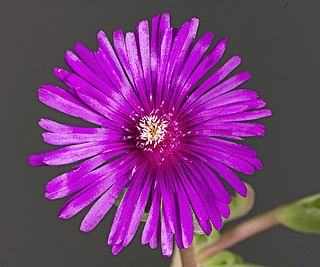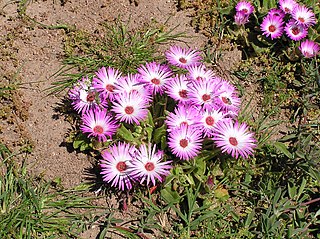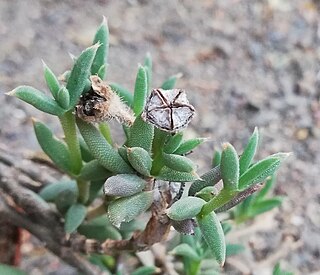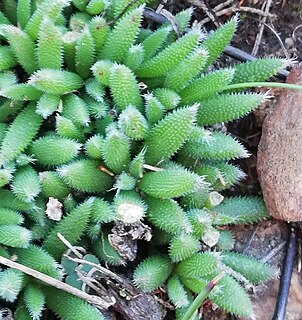
The Aizoaceae, or fig-marigold family, is a large family of dicotyledonous flowering plants containing 135 genera and about 1800 species. They are commonly known as ice plants or carpet weeds. They are often called vygies in South Africa and New Zealand. Highly succulent species that resemble stones are sometimes called mesembs.

Delosperma is a genus of around 170 species of succulent plants, formerly included in Mesembryanthemum in the family Aizoaceae. It was defined by English botanist N. E. Brown in 1925. The genus is common in southern and eastern Africa. Delosperma species, as do most Aizoaceae, have hygrochastic capsules, opening and closing as they wet and dry.

Trichodiadema bulbosum is a succulent plant of the genus Trichodiadema, native to South Africa.

Glottiphyllum depressum is a common species of succulent plant, of the family Aizoaceae, native to South Africa.

Dorotheantheae is a small tribe of annual succulents in the Aizoaceae subfamily Ruschioideae. Though it originally comprised three genera, Cleretum remains as the only recognised genus. Dorotheantheae are endemic to the western and south-western parts of South Africa. The type genus is Dorotheanthus, despite it being no longer recognised.

Trichodiadema marlothii is succulent plant of the genus Trichodiadema, native to the Western Cape Province, South Africa, where it is known from the Robertson and Swellendam areas.

Trichodiadema intonsum is succulent plant of the genus Trichodiadema, native to the Eastern Cape Province, South Africa.

|}}
Trichodiadema burgeri is succulent plant of the genus Trichodiadema, native to the Western Cape Province, South Africa, where it is known from the Ladismith and Oudtshoorn regions, extending southwards towards Mossel Bay.

Trichodiadema densum is a succulent flowering plant in the fig-marigold family Aizoaceae, native to the Willowmore region of the Western Cape Province, South Africa.
Trichodiadema attonsum is succulent plant of the genus Trichodiadema, native to the Western Cape Province, South Africa, where it is common among pale quartzite rocks in the western Little Karoo region. Unlike most other species in its genus, it does not have a typical diadem on its leaf-tips.

Trichodiadema gracile is succulent plant of the genus Trichodiadema, native to the Western Cape Province, South Africa, where it is common on dry, rocky hillsides in the Overberg region.

Trichodiadema calvatum is succulent plant of the genus Trichodiadema, native to the Western Cape Province, South Africa, where it is found in shales, in open rocky areas within Renosterveld vegetation.

Trichodiadema occidentale is succulent plant of the genus Trichodiadema, native to the Western Cape Province, South Africa, where it grows in rocky shale or limestone hills in the Overberg region, and especially in disturbed areas.

Trichodiadema pygmaeum is succulent plant of the genus Trichodiadema, native to the Western Cape Province, South Africa, where it is found in fine-grained soils in the regions of Bredasdorp and Swellendam.
Trichodiadema hallii is succulent plant of the genus Trichodiadema, native to the Ladismith and Calitzdorp areas of the Western Cape Province, South Africa.
Trichodiadema strumosum is succulent plant of the genus Trichodiadema, native to the Western Cape Province, South Africa, where it is found in loam-based soils in the Fynbos vegetation of the Swellendam region.

Trichodiadema barbatum is succulent plant of the genus Trichodiadema, native to the Eastern Cape Province, South Africa.

Trichodiadema introrsum is succulent plant of the genus Trichodiadema, native to the Eastern Cape Province, South Africa. It occurs in the vicinity of the towns of Bedford, Grahamstown and Kirkwood.

Trichodiadema pomeridianum is a succulent plant of the genus Trichodiadema, widespread in the arid central Karoo regions of South Africa.

















